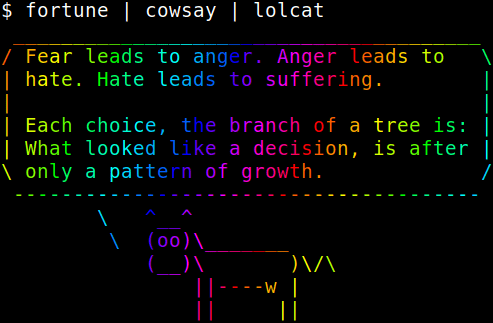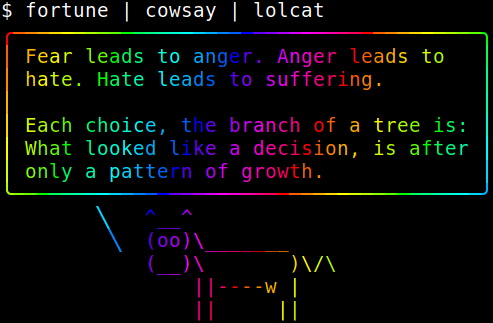Cowsay UTF Borders
Nice borders for cowsay. Also features a small lolcat implementation.
A simple cowsay patch replaces the hardcoded baloon borders with more appealing UTF-8 equivalents.
The different ASCII art “cowfiles” are left unchanged.
--- /usr/games/cowsay
+++ cowsay
@@ -146,16 +146,18 @@ sub construct_balloon {
@border = qw[ / \ \ / | | ];
}
}
+ @border = ("\x{2502}", "\x{2502}", "\x{2502}", "\x{2502}", "\x{2502}", "\x{2502}");
+ $thoughts = "\x{2572}";
## no trailing spaces (#276144)
push(@balloon_lines,
- " " . ("_" x $max2) . "\n" ,
+ "\x{256D}" . ("\x{2500}" x $max2) . "\x{256E}\n" ,
sprintf($format, $border[0], colstr($message[0], $max), $border[1]),
(@message < 2 ? "" :
map { sprintf($format, $border[4], colstr($_, $max), $border[5]) }
@message[1 .. $#message - 1]),
(@message < 2 ? "" :
sprintf($format, $border[2], colstr($message[$#message], $max), $border[3])),
- " " . ("-" x $max2) . "\n"
+ "\x{2570}" . ("\x{2500}" x $max2) . "\x{256F}\n"
);
}
lolcat
The simplified lolcat implementation from above uses the main 256 color wheel in pure Python:
#!/usr/bin/env python3
import sys
COLOR_WHEEL = [196, 202, 208, 214, 220, 226, 190, 154, 118, 82, 46, 47, 48, 49, 50,
51, 45, 39, 33, 27, 21, 57, 93, 129, 165, 201, 200, 199, 198, 197]
def colorize(line: str, idx: int) -> str:
return "".join("\x1b[38;5;{}m{}".format(COLOR_WHEEL[(idx + i) % len(COLOR_WHEEL)], c)
if not c.isspace() else c
for i, c in enumerate(line)) + "\x1b[0m"
def main() -> int:
idx: int = 0
while line := sys.stdin.readline():
sys.stdout.write(colorize(line, idx))
idx += 1
return 0
if __name__ == "__main__":
sys.exit(main())

